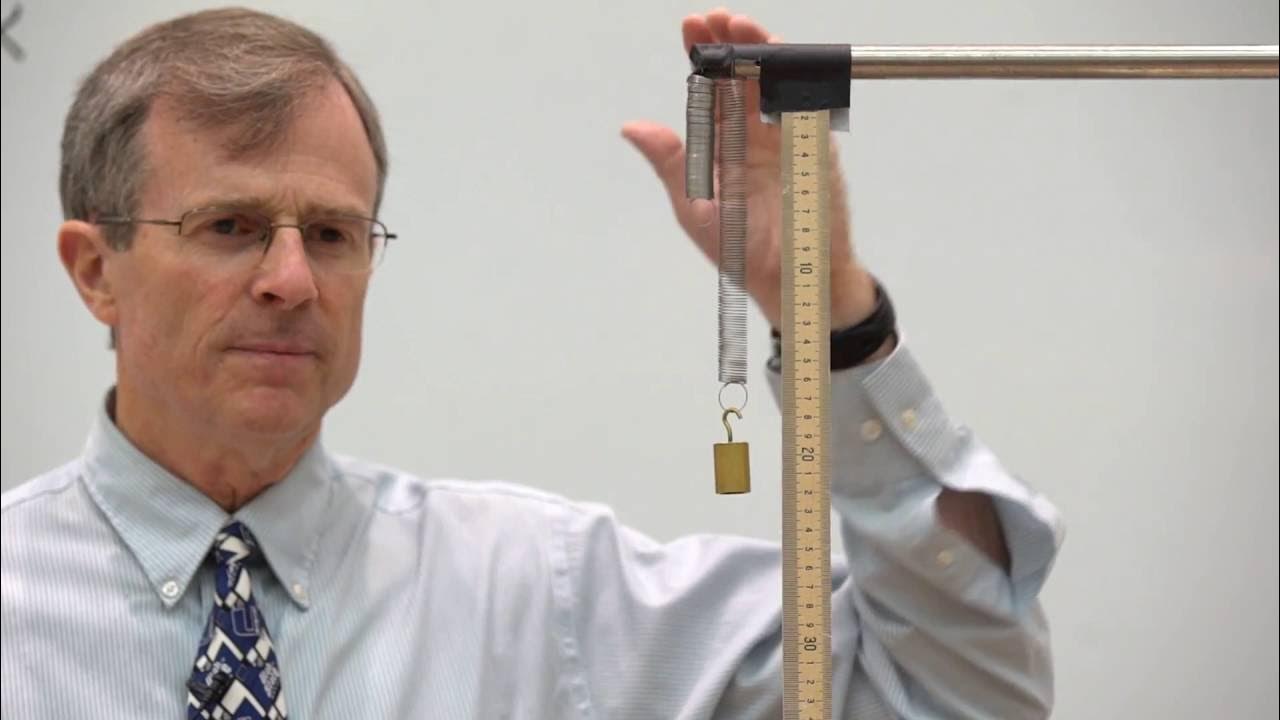Period dependence for mass on spring | Physics | Khan Academy
Summary
TLDRThis educational video script explores the principles of a mass oscillating on a spring, focusing on amplitude and period. It clarifies that amplitude is determined by the displacement of the mass but does not affect the period. The period, instead, is solely dependent on the mass and the spring constant, as described by the formula T = 2π √(m/k). The script debunks the misconception that a larger amplitude leads to a longer period, explaining that the increased distance is compensated by a higher velocity due to Hooke's law. It also emphasizes that the period is independent of gravitational force, making the formula applicable in any gravitational environment.
Takeaways
- 🔍 The amplitude of oscillation is determined by the displacement of the mass from its equilibrium position.
- ⏱ The period of oscillation is the time it takes for the mass to complete one full cycle of motion.
- 🔄 Increasing the amplitude does not affect the period of oscillation; the mass travels farther but also moves faster, offsetting each other.
- 📐 Hooke's law states that the force exerted by a spring is proportional to the displacement from the equilibrium position.
- 📉 The period of a mass on a spring is given by the formula T = 2π √(m/k), where T is the period, m is the mass, and k is the spring constant.
- 🚀 The period is independent of the amplitude of oscillation, but it is affected by the mass and the spring constant.
- 🌌 The period of oscillation is not affected by gravity, so it remains the same even if the mass is oscillating vertically or horizontally.
- 📈 Increasing the mass results in a longer period due to increased inertia.
- 📉 Increasing the spring constant k results in a shorter period because the spring can exert a larger force, moving the mass more quickly.
- 🔍 The formula for the period of a mass on a spring can be derived using calculus and is applicable to both simple harmonic motion and energy considerations.
Q & A
What is the amplitude of an oscillating mass on a spring?
-The amplitude is the maximum displacement from equilibrium, determined by the person or force pulling the mass back.
What is the period of oscillation for a mass on a spring?
-The period is the time it takes for the mass to complete one full cycle of oscillation.
Does increasing the amplitude of oscillation affect the period?
-No, changes in amplitude do not affect the period of oscillation. The period remains constant regardless of the amplitude.
What factors determine the period of a mass oscillating on a spring?
-The period depends on the mass of the object and the spring constant, not on the amplitude of oscillation.
What is the formula for the period of a mass on a spring?
-The formula for the period (T) of a mass on a spring is T = 2π √(m/k), where m is the mass and k is the spring constant.
Why does increasing the mass result in an increased period?
-Increasing the mass increases the period because a larger mass has more inertia, making it more difficult to change its motion, thus taking longer to complete a cycle.
How does the spring constant affect the period of oscillation?
-An increase in the spring constant (k) results in a smaller period because the force exerted by the spring is greater, allowing the mass to move more quickly through its cycle.
Does the direction of oscillation (horizontal or vertical) affect the period?
-No, the direction of oscillation does not affect the period. The same formula applies to both horizontal and vertical oscillations.
Is the gravitational acceleration a factor in determining the period of a mass on a spring?
-No, the gravitational acceleration does not affect the period of a mass on a spring. The period is independent of the gravitational constant.
Can the formula for the period of a mass on a spring be derived without calculus?
-The formula can typically be derived using calculus, specifically in the context of simple harmonic motion. The instructor suggests watching videos on simple harmonic motion with calculus for the derivation.
Outlines

This section is available to paid users only. Please upgrade to access this part.
Upgrade NowMindmap

This section is available to paid users only. Please upgrade to access this part.
Upgrade NowKeywords

This section is available to paid users only. Please upgrade to access this part.
Upgrade NowHighlights

This section is available to paid users only. Please upgrade to access this part.
Upgrade NowTranscripts

This section is available to paid users only. Please upgrade to access this part.
Upgrade NowBrowse More Related Video

De qué depende el periodo para una masa en un resorte | Física | Khan Academy en Español

Demonstrating What Changes the Period of Simple Harmonic Motion(SHM)

Oscillations Demo: Mass Spring System

Fisika SMA - Gerak Harmonik (1) - Pengenalan Gerak Harmonik Sederhana, Periode dan Frekuensi (I)

Demonstrating Position, Velocity, and Acceleration of a Mass-Spring System

M H S aula 03
5.0 / 5 (0 votes)